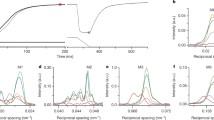Abstract
-
1.
Cardiac muscle fragments with disrupted sarcolemma were prepared by homogenization of mouse ventricles. The preparations exhibited spontaneous contractions of a rate between 3 min−1 and 12 min−1. at 20° C, when they were kept in an appropriate solution.
-
2.
Fragments of about cellular size were attached to two stiff glass microelectrodes, and additional contractions between the spontaneous beats were elicited by current pulses. The duration and intensity of the stimuli were varied to obtain strength-duration curves. Rheobase was in the range of 1.5 μA to 10 μA (no isolation of surrounding bath), chronaxia at 35° C between 30 ms and 80 ms.
-
3.
One microelectrode could be glued to a photodiode-force-transducer for simultaneous recording of contractions and electrical stimulation or potential measurement. Duration of phasic contractions was nearly 1 s, force was up to 4 μN (20 mN/mm2 of tension).
Similar content being viewed by others
References
Bloom, S., Brady, A. J., Langer, G. A.: Calcium metabolism and active tension in mechanically disaggregated heart muscle. J. Mol. Cell. Cardiol.6, 137–147 (1974)
Collins, E. W., Edwards, C.: Role of Donnan equilibrium in the resting potentials in glycerol-extracted muscle. Am. J. Physiol.221, 1130–1133 (1971)
Costantin, L. L., Podolsky, R. J.: Depolarization of the internal membrane system in the activation of frog skeletal muscle. J. Gen. Physiol.50, 1101–1124 (1967)
DeClerck, N. M., Claes, V. A., Brutsaert, D. L.: Force velocity relations of single cardiac muscle cells. J. Gen. Physiol.69, 221–241 (1977)
Ebashi, S.: Excitation-contraction coupling. Ann. Rev. Physiol.38, 293–313 (1976)
Ebashi, S., Endo, M.: Calcium ion and muscle contraction. In: Progress in biophysics and molecular biology (Butler, J. A. V., Noble, D., eds.), pp. 123–183, Oxford: Pergamon Press 1968
Endo, M., Tanaka, M., Ogawa, Y.: Calcium induced release of calcium from the sarcoplasmic reticulum of skinned skeletal muscle fibres. Nature228, 34–36 (1970)
Endo, M., Nakajima, Y.: Release of calcium induced by “depolarization” of the sarcoplasmic reticulum membrane. Nature New Biol.246, 216–218 (1973)
Fabiato, A., Fabiato, F.: Excitation-contraction coupling of isolated cardiac fibers with disrupted or closed sarcolemmas. Circ. Res.31, 293–307 (1972)
Fabiato, A., Fabiato, F.: Contractions induced by a calciumtriggered release of calcium from the sarcoplasmic reticulum of single skinned cardiac cells. J. Physiol. (Lond.)249, 469–495 (1975)
Fabiato, A., Fabiato, F.: Techniques of skinned cardiac cells and of isolated cardiac fibers with disrupted sarcolemmas with reference to the effects of catecholamines and of caffeine. In: Recent advances in studies on cardiac structure and metabolism, Vol. 9, The sarcolemma, (Roy, P. E., Dhalla, N. S., eds.), pp. 71–94. Baltimore: University Park Press 1976
Fabiato, A., Fabiato, F.: Calcium release from sarcoplasmic reticulum. Circ. Res.40, 119–129 (1977)
Fabiato, A., Fabiato, F., Sonnenblick, E.: Properties of internal membranes of isolated cardiac fibers with disrupted sarcolemma. Fed. Proc.30, 668 Abs. (1971)
Ford, L. E. Podolsky, R. J.: Regenerative calcium release within muscle cells. Science167, 58–59 (1970)
Meiss, R. A.: A versatile transducer system for mechanical studies of muscle. J. Appl. Physiol.37, 459–463 (1974)
Melchior, N. C.: Sodium and potassium complexes of adenosine triphosphate: equilibrium studies. J. Biol. Chem.208, 615–627 (1954)
Nanninga, L. B.: The association constant of the complexes of adenosine triphosphate with magnesium, calcium, strontium, and barium ions. Biochim. Biophys. Acta54, 330–338 (1961)
Natori, R.: The property and contraction process of isolated myofibrils. Jikeikai Med. J.1, 119–126 (1954)
Natori, R.: The electric potential change of internal membrane during propagation of contraction in skinned fibre of toad skeletal muscle. Jap. J. Physiol.25, 51–63 (1975)
Ringbom, A.: Complexation in analytical chemistry. New York: Intersience Publishers 1963
Schwarzenbach, G., Seen, H., Anderegg, G.: Komplexone XXIX. Ein großer Chelateffekt besonderer Art. Helv. Chim. Acta40, 1886–1900 (1957)
Sillén, L. G., Martell, A. E.: Stability constants of metal-ion complexes. London: The Chemical Society 1964
Thorens, S., Endo, M.: Calcium-induced calcium release and “depolarization”-induced calcium release: Their physiological significance. Proc. Jap. Acad.51, 473–478 (1975)
Trube, G.: Contractions of skinned cardiac muscle fragments elicited by electrical simulation (abstr.). Pflügers Arch.358, R4 (1977)
Winegrad, S.: Intracellular calcium binding and release in frog heart. J. Gen. Physiol.62, 693–706 (1973)
Author information
Authors and Affiliations
Additional information
This work was supported by the Deutsche Forschungsgemeinschaft, SFB 38, Membranforschung, Projekt G.
Rights and permissions
About this article
Cite this article
Trube, G. Contractions of skinned cardiac cells elicited by current pulses. Pflugers Arch. 376, 217–222 (1978). https://doi.org/10.1007/BF00584953
Received:
Issue Date:
DOI: https://doi.org/10.1007/BF00584953




